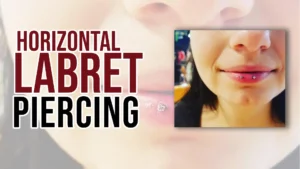Single-point piercings are another name for dermal piercings. That’s because, unlike typical piercings, dermal don’t have a distinct entry and exit point for jewelry.
However, your piercer will make a single, small opening to allow for the implantation of an “anchor” into the dermis, or middle layer, of your skin. About 6 or 7 millimeters in length, the anchor’s base is only long enough to hold the post in place.
Dermal jewelry is not a surface piercing, despite the fact that it rests on the top layer of your skin. Surface piercings have two distinct points of entry and exit. They are fastened by barbells that resemble open staples. Under the skin, this barbell is implanted. However, the tops of the jewels sit on the skin’s surface.
Where does a dermal piercing go?
Anything on the body there is flat skin is suitable for a dermal piercing.
- Chest
- Lower back
- Cheekbones
- The nape of the neck is a famous place.
- Abdomens
- Thighs
There are no absolutely forbidden areas, but the skin must be thick enough to retain the dermal piercing in place.
Which jewelry kinds are utilized for this piercing?
A skin (dermal) punch or needles can be used to pierce the skin. The method of piercing determines the type of jewelry that is utilized.
Both a needle and a skin (dermal) punch can be used to perform a dermal piercing. Based on how the piercing is done, a particular form of jewelry may be used.
These are your options:
- An anchor is first put under your skin to begin a typical dermal pierce. You can choose to have flat “feet” on each side of the post or a rounded base for your anchor.
- Your piercer will add the jewelry you’ve chosen to the anchor after it has been inserted. Metal studs or magnet gems are a couple of examples.
What material options are available for the jewelry?
The following choices should be explored with your piercer:
- Titanium is used in surgery. Titanium could be the least likely material to irritate the skin if you have an issue with sensitive skin.
- Stainless surgical steel. According to TatRing, this is the most widely used material. Although being thought of being hypoallergenic, inflammation is still a possibility.
- This is another allergenic, non-corroding material.
How is this piercing done?
Skin punches or needles are used for dermal piercings. An anchor is inserted beneath the skin in each method. For a needle-based dermal piercing:
- Your skin will be cleaned properly and made sterile by your piercer.
- To make sure the piercing is made in the proper location. They will mark your skin with a pen or marker after the region has healed.
- The skin will be pierced by the needle, and it will be pulled back out. As a result, the anchor has a “pocket” to fit in.
- Your piercer will screw the jewelry top on after the anchor has been set.
- Your piercer will use similar procedures as above to do a dermal piercing with a skin punch. The exception is that a punch will be used to create the hole rather than a needle. The pocket where the anchor will rest is made by the skin punch, which removes a tiny piece of tissue.
Will Dermal Piercing Really hurt?
All piercings are responsible for some pain. Dermal is no different. There are various variables that can affect how you feel during the piercing process, including:
- The site of the procedure (the more fleshy the area, the less probable it will hurt). (dermal punches are considered less painful)
- Your personal tolerance for pain;
- The skill and reputation of your piercer
Conclusion:
Typically, a dermal piercing takes one to three months to heal. The healing process for the piercing could be slowed down if you don’t adhere to your piercer’s aftercare instructions.
During the first few weeks, modest swelling and crusting around the jewelry top are typical. As the healing process progresses, these symptoms will gradually fade. Unless the pierced is also leaking yellow or green pus hot to the touch or exhibits other symptoms of illness, they often aren’t a warning sign!
FAQs:
What should I be aware of before obtaining a dermal piercing?
Dermal piercings will cause some pain, just like any other form of body modification. You will almost certainly experience some discomfort, whether it be a pinch or something more visceral unless your pain tolerance is really high. According to Darling, dermal piercings feel like pressure.
Do dermal piercings frequently fall out?
Dermal pierces are prone to spread and rejection, just like conventional surface piercings. A dermal anchor with holes in the bases that are implanted might decrease the probability. It will migrate out. In order to prevent snag, displacement, or pulling out of your dermal piercing while it is healing, it is also crucial to cover it.
How long do dermal piercings take to heal?
For at least six weeks, the region must continue to be washed with salt water once each day. Microdermal repair may take six months (especially internally).





